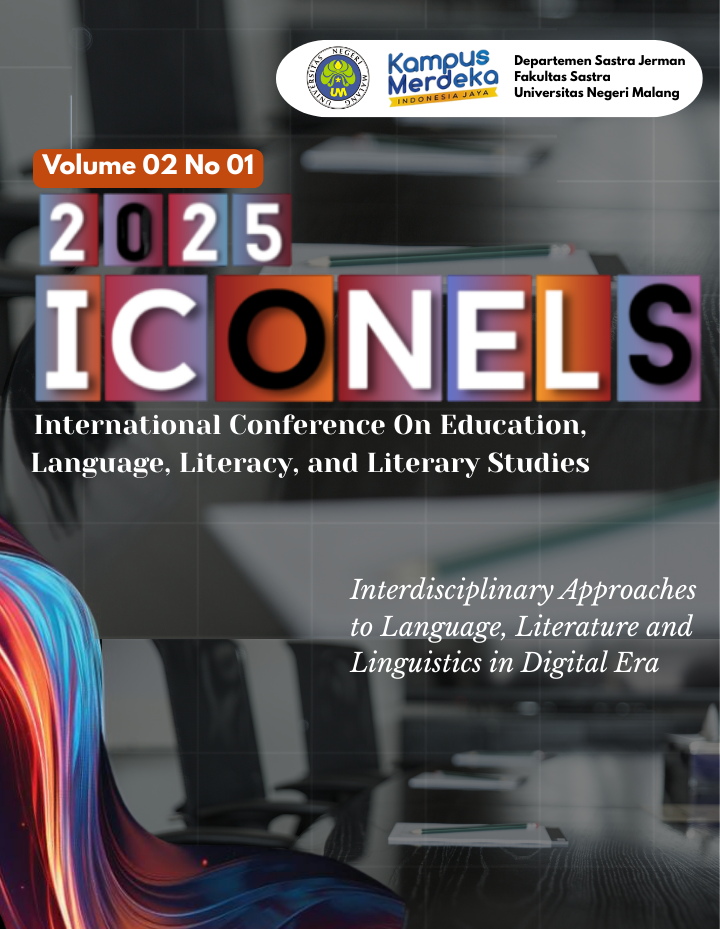Identifying the Semiotic Meaning of Li Bai's Poetry to Support the Learning of Chinese Literature Courses
DOI:
https://doi.org/10.63011/iconels.v2i1.73Keywords:
Semiotika, Poetry, Li Bai, Chinese literatureAbstract
This study aims to describe the sign system in the form of icons, indexes, and symbols in three poems by Li Bai entitled 玉阶怨 [yù jiē yuan] ‘Fretting on the Jade Staircase’, 怨情 [yuàn qíng] ‘Revenge’, and下江陵 [xià jiānglíng ‘down to Jiangling’. This research uses qualitative method and Peirce's semiotic analysis approach in the form of analytical description. The data sources in this study are three poetry texts contained in the book Tangshi Yibai Shou. The data were collected using reading and note-taking techniques. From the analysis, it can be seen that there is a whole system of signs, especially indexes and symbols that represent life in the Tang dynasty. This proves the existence of signs and relationships to the objects they represent. The relationship is in the form of similarity, convention, and existence to the object. The poems contain themes of longing, separation, sadness, and reflections on the relationship between humans and nature that represent life during the Tang dynasty. Semiotics in this study not only helps in interpreting Li Bai's poems, but also serves as a learning tool in Chinese literature courses. Through understanding the meanings in the poems, students can learn more about the culture and historical background that influenced the birth of these literary works.
References
Anthony, C. Y. (2012). The Journey to the West, Revised Edition, Volume 1 (Vol. 1). University of Chicago Press.
Creswell, J. W. (2014). The selection of a research approach. Research design: Qualitative, quantitative, and mixed methods approaches, 3-24.
Fischer, A. H., & Manstead, A. S. (2008). Social functions of emotion. Handbook of Emotions,3, 456–468.
Fridlund, A. J. (2014). Human facial expression: An evolutionary view. Academic press.
Givens, D. B., & White, J. (2021). The Routledge dictionary of nonverbal communication. Routledge.
Hasanah, D. U., Achsani, F., & Akbar Al Aziz, I. S. (2019). ANALISIS PENGGUNAAN GAYA BAHASA PADA PUISI- PUISI KARYA FADLI ZON. KEMBARA Journal of Scientific Language Literature and Teaching, 5(1), 13. https://doi.org/10.22219/kembara.v5i1.8187
Hector, V. (2013). Chinese Bead Curtains, Past and Present. BEADS: Journal of the Society of Bead Researchers, 25(1), 40–71.
Hwang, H. C., & Matsumoto, D. (2016). Facial expressions.
Husnah, W. (2016). Tinjauan Buku kesusastraan Tiongkok dari masa ke masa. Jurnal Kajian Wilayah, Vol. 7 No. 1, 2016.
Keltner, D. (2003). Expression and the course of life: Studies of emotion, personality, and psychopathology from a social-functional perspective. Annals of the New York Academy of Sciences, 1000(1), 222–243.
Laube, E. (2022). The 1937 Trajectory of a Miniature Pagoda: Jade, Politics of the Nation, and an Exposition Attempt. The Ohio State University.
Lavrač, M. (2015). On Parting, Separation and Longing in the Chinese Poetic Tradition. Interlitteraria, 20(2), 105–122.
Lazarus, R. S. (2013). Fifty years of the research and theory of RS Lazarus: An analysis of historical and perennial issues. Psychology Press.
Liu, Y. (2019). Reconstructing cultural memory through landscape photography in China, 2000–2010.
Martin, K., & Ronnberg, A. (2010). The book of symbols: Reflections on archetypal images. Illustrated. Cologne: TASCHEN.
Philo, C. (Ed.). (2008). Theory and methods: Critical essays in human geography. Ashgate.
Popova, M. D. (2023). ARTISTIC AND AESTHETIC UNDERSTANDING OF BEAUTY IN CHINESE POEMS. Тrаnscarpathian Philological Studies, 1(27), 226–230. https://doi.org/10.32782/tps2663-4880/2022.27.1.38
Setiawan, S., Sudrajat, R. T., & Sukawati, S. (2020). ANALISIS UNSUR BATIN DALAM PUISI “KONTEMPLASI” KARYA IKA MUSTIKA. Parole (Jurnal Pendidikan Bahasa dan Sastra Indonesia), 3.
Sin-wai, C. (2020). The Routledge encyclopedia of traditional Chinese culture. London: Routledge.
Souppez, J.-B. R. G. (2023). STRUCTURAL DESIGN OF WOODEN BOATS. Historic Ships 2023. https://doi.org/10.3940/rina.hs.2023.06
Stillinger, J. (2008). Romantic Complexity: Keats, Coleridge, and Wordsworth. University of Illinois Press.
Sutami, H. (2024). Chinese Studies (Sinologi) di Perguruan Tinggi. Jurnal Cakrawala
Mandarin, 8(1), 25-32.
Wang, M. (2018). Resource and social identity: Jade usage in the Neolithic Liangzhu culture, China, and the modern display and uses of Liangzhu jade artifacts. tesis de maestría, Graduate School of Arts and Sciences, Universidad de Boston.
Wang-Wolf, X. (2021). Silk and Sacrifice: Gender, Death, and Adaptation in Two Chinese Literary Traditions. Arizona State University.
Williams, C. A. S. (2012). Chinese symbolism and art motifs fourth revised edition: A
comprehensive handbook on symbolism in Chinese art through the ages. Tuttle Publishing.
Wulandari, C. (2016). Unsur Melankolis Puisi Dalam Komik Puisi Dinasti Tang Yang Dikumpulkan Oleh Yangyangtu. Jurnal Bahasa Mandarin, 1(01).
Wulandari, S., & Siregar, E. D. (2020). Kajian Semiotika Charles Sanders Pierce: Relasi Trikotomi (Ikon, Indeks dan Simbol) dalam Cerpen Anak Mercusuar Karya Mashdar Zainal. Titian: Jurnal Ilmu Humaniora, 4(1), 29-41.
Xia, C. (2021). Poetry and emotion in classical Chinese literature. In The Routledge handbook of Chinese studies (pp. 289–303). Routledge.
Yang, J. (2007). The Chan interpretations of Wang Wei’s poetry: A critical review.
Yuan, Q., & Hawkes, D. (1985). The Songs of the South: An Anthology of Ancient Chinese Poems by Qu Yuan and Other Poets. Trans. David Hawkes. New York: Penguin.
Downloads
Published
Issue
Section
License
Copyright (c) 2025 Nur Ainul Hanifah, Amira Eza Febrian Putri, Duddy Syafruddin, Dhevy Olivia Firdaus

This work is licensed under a Creative Commons Attribution-NonCommercial-ShareAlike 4.0 International License.



